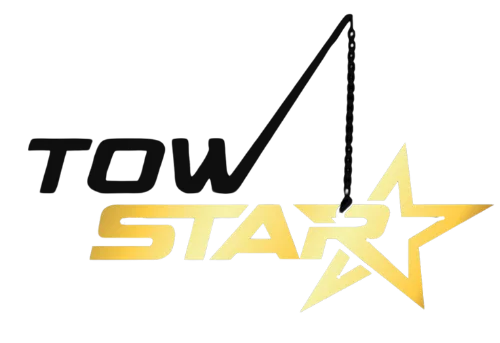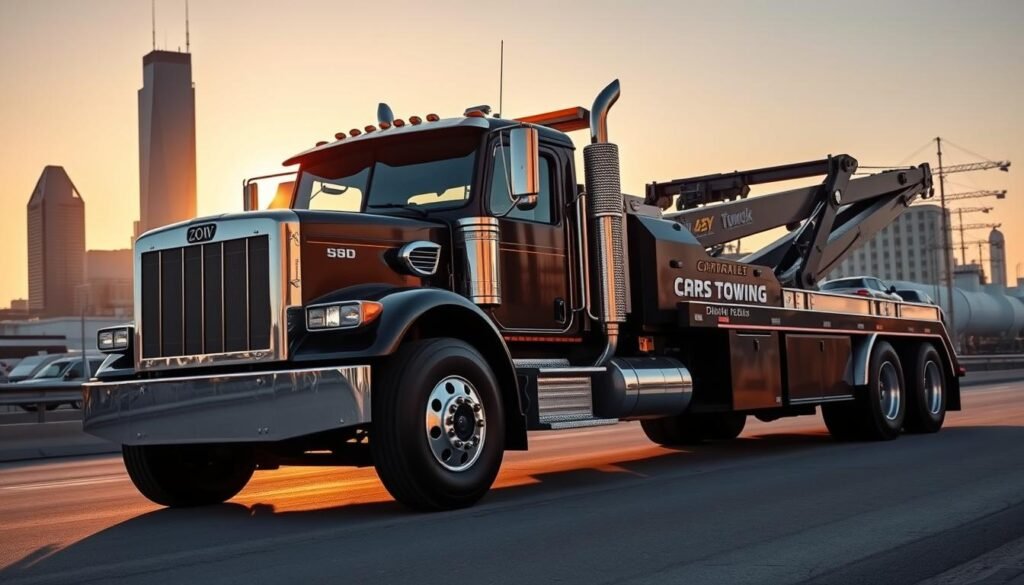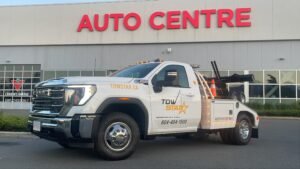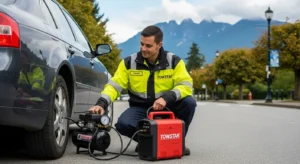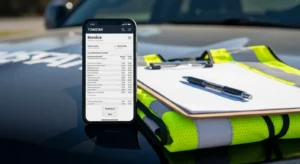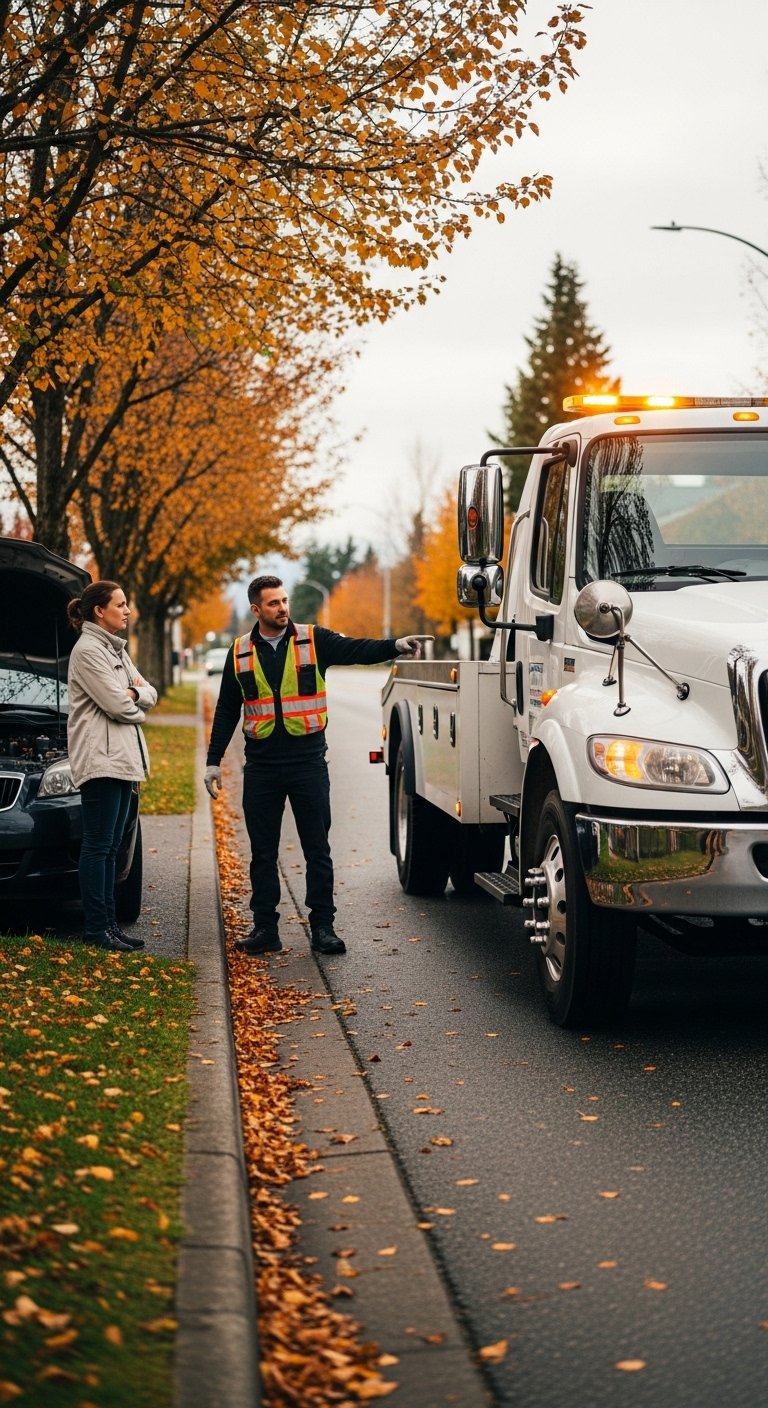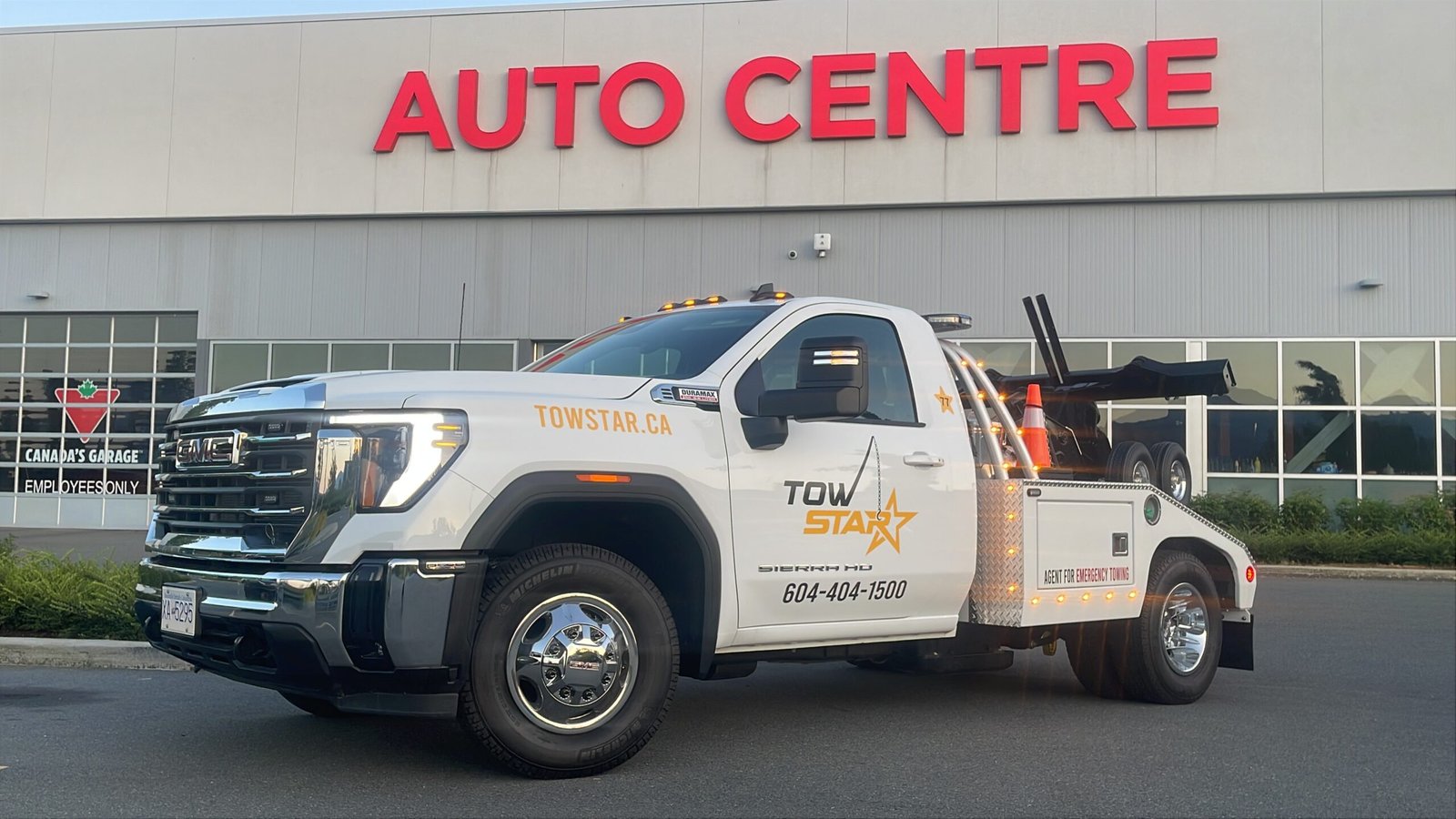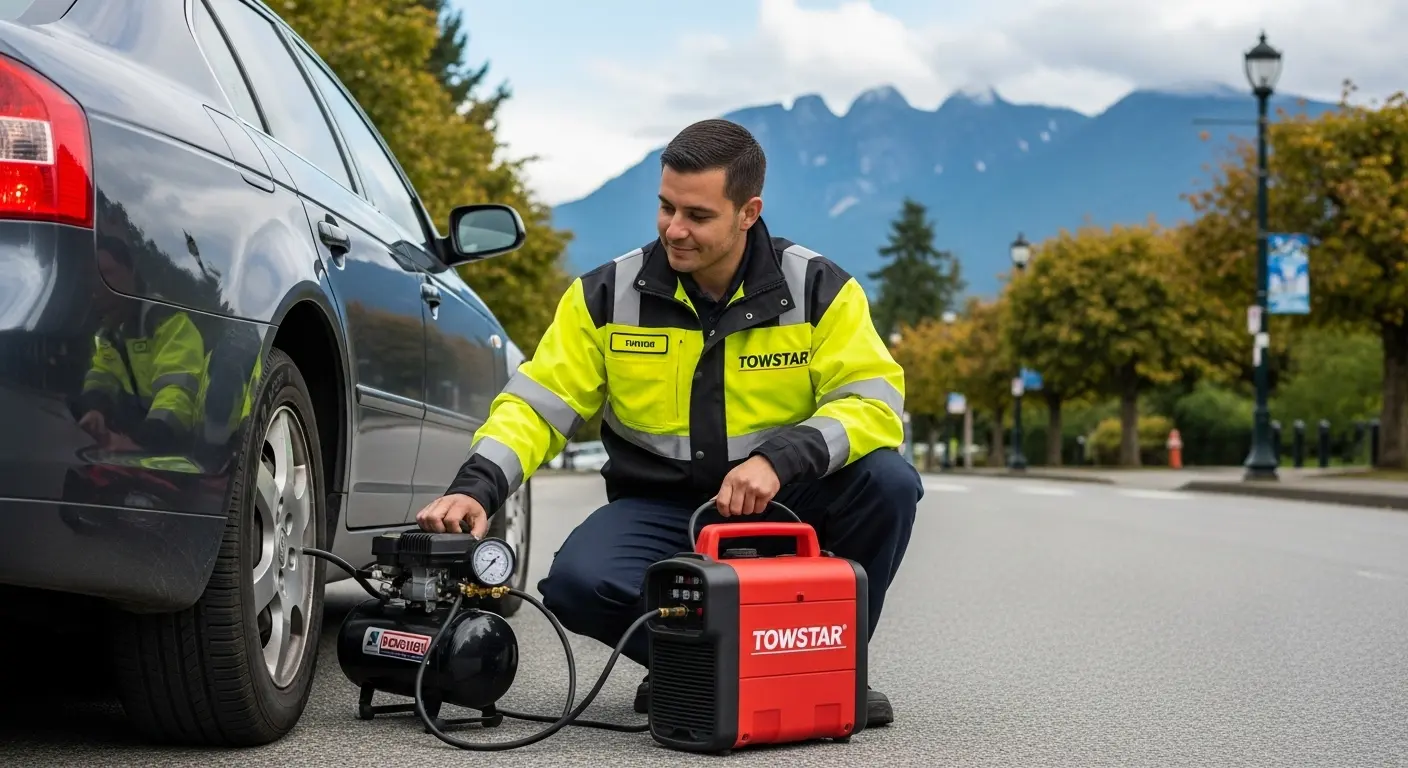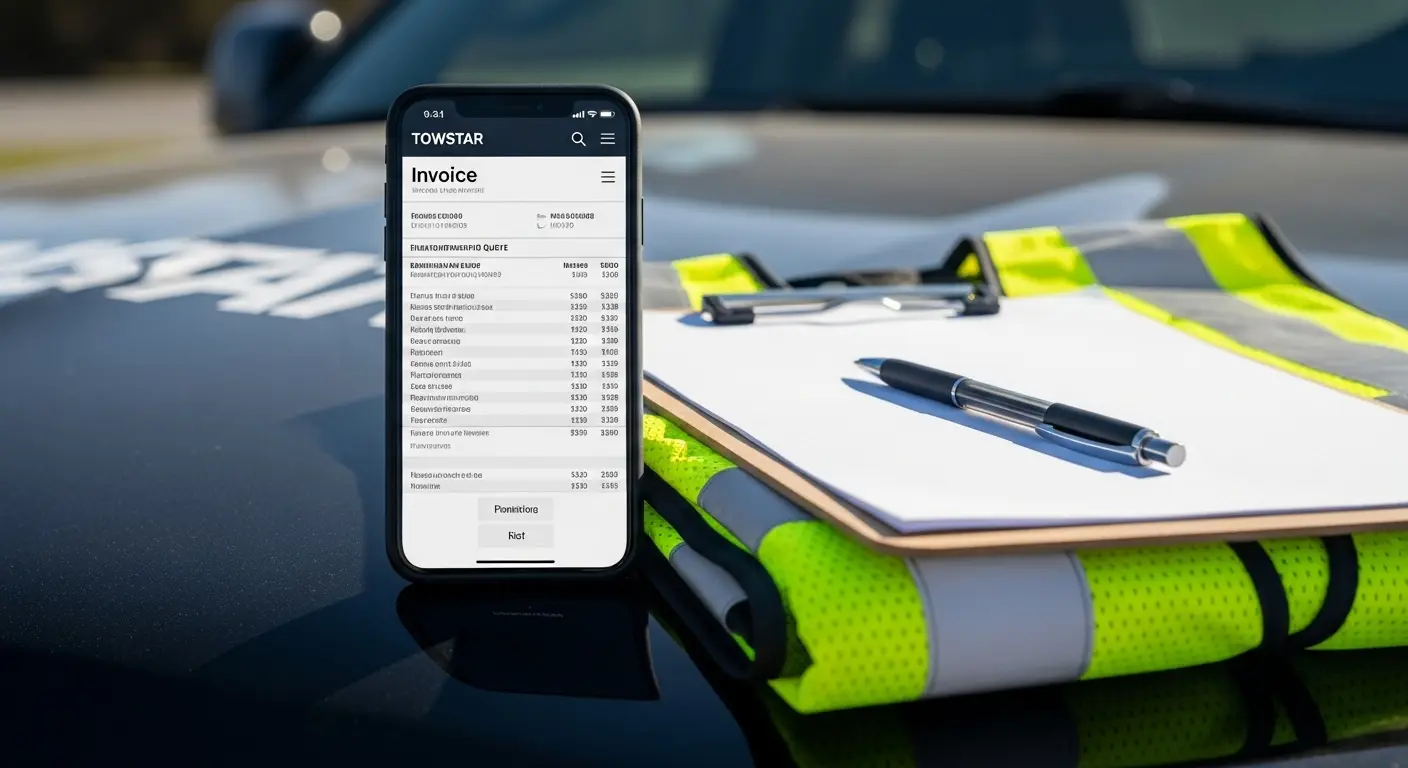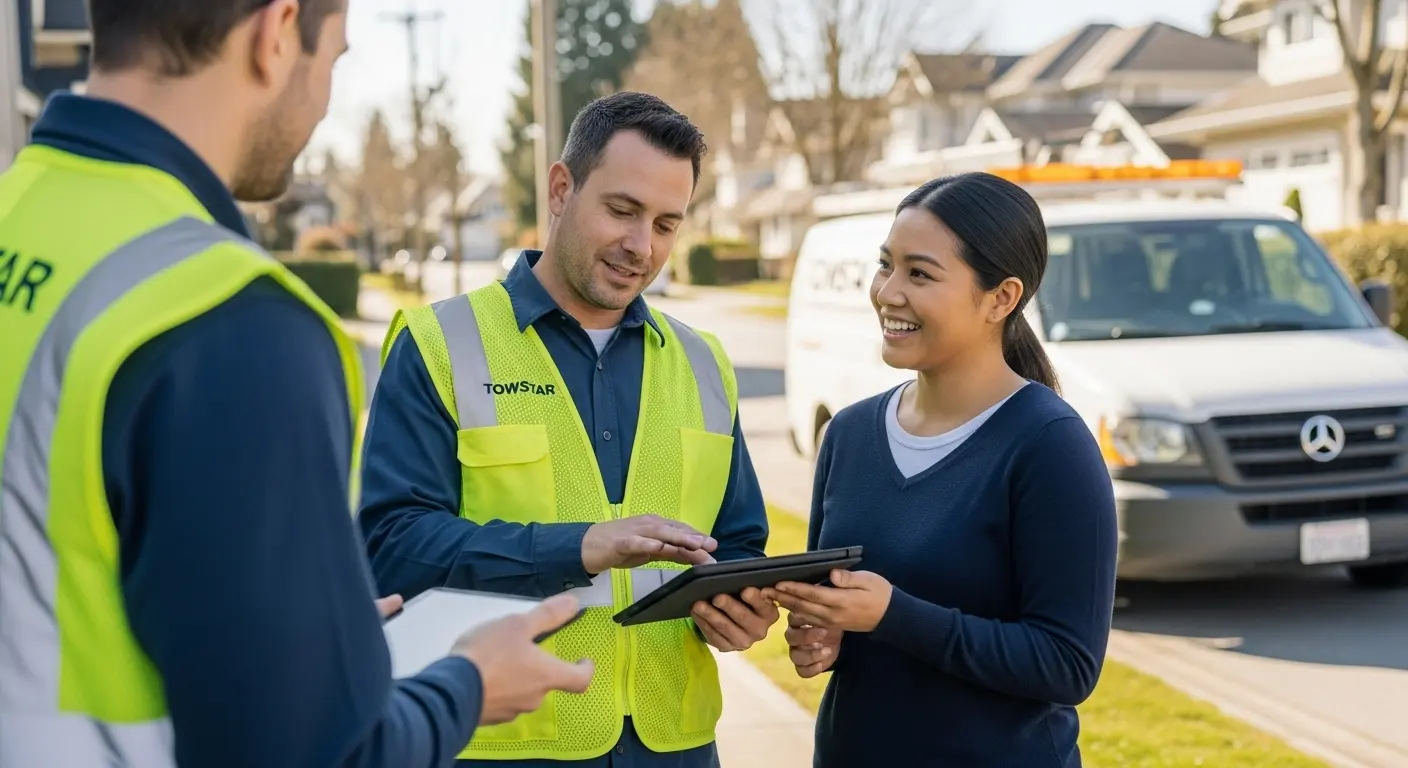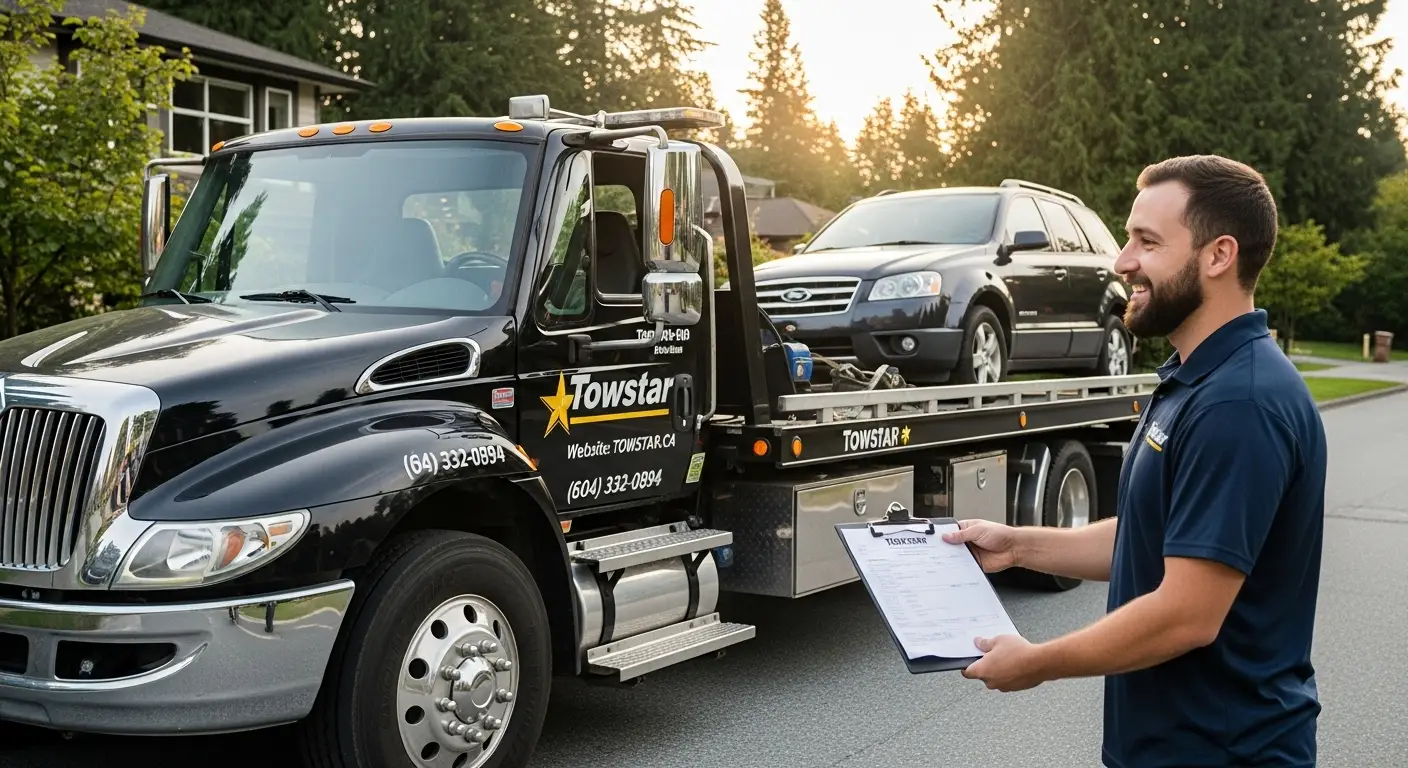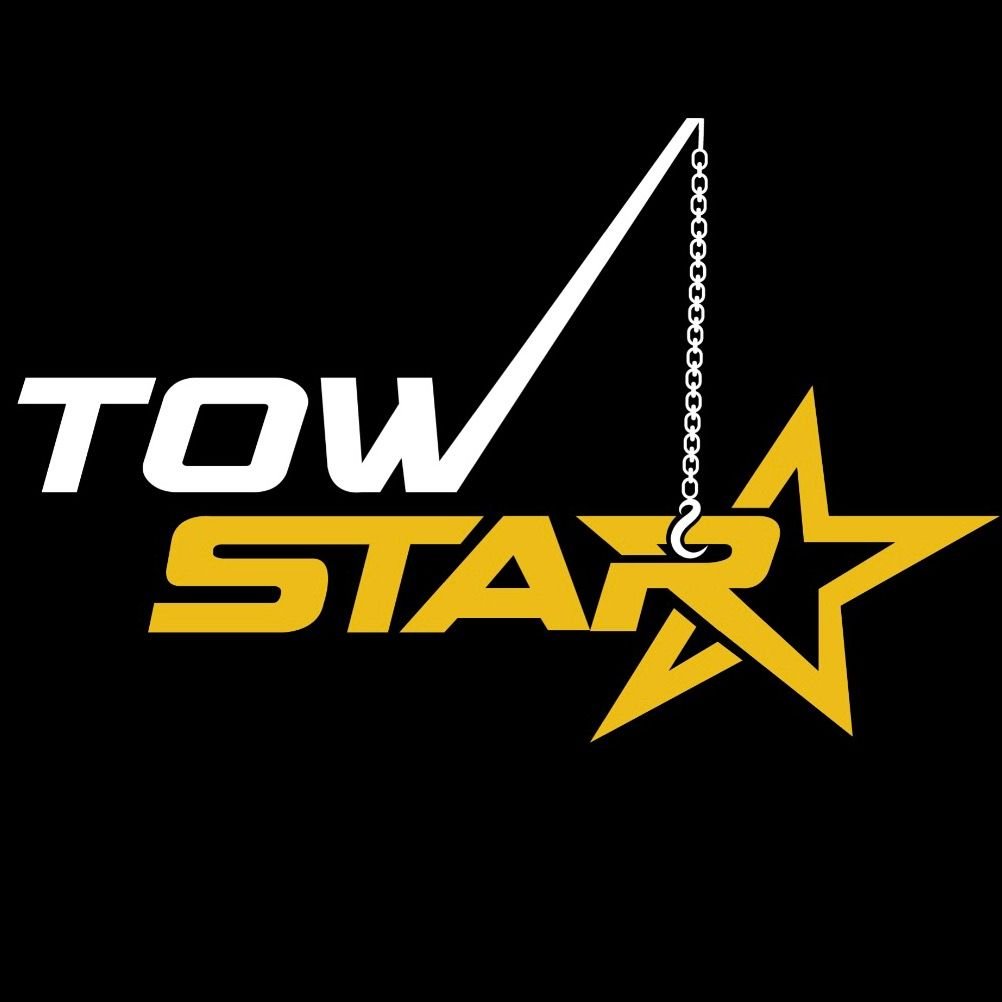Imagine driving through Alberta’s Rocky Mountains with a big load. Knowing your truck well is not just wise—it’s critical. This guide gives you the latest on 2025’s heavy-duty towing, tech, and safety tips for moving big loads with confidence.
The 2025 Ford F-150’s engine can pull up to 13,500 lbs. That’s enough for most campers or work trailers. GMC Sierra’s updated payload lets you carry heavier tools easily. But, it’s not just about power. The right gear and upkeep keep you safe on the road.
This year, smart hitch systems and tire-pressure monitors are new. They auto-adjust for sway control and send text alerts to your phone. Whether you’re helping stranded drivers or moving machinery, we’ll guide you to the right rigs. No complicated terms, just clear, useful info for today.
Key Takeaways
- Compare 2025 Ford and GMC truck specs for optimal towing performance
- Understand why equipment maintenance prevents roadside emergencies
- Discover new tech upgrades improving safety during hauls
- Learn how to calculate payloads for different trailer types
- Get tips for choosing reliable service providers in your area
Introduction to Heavy Duty Tow Trucks
Imagine a semi-trailer overturned on Highway 401. Your regular tow truck looks like a toy. Heavy duty tow trucks are the heroes of roadside help, ready for big challenges.
What Is a Heavy Duty Tow Truck?
These trucks are not just big; they’re rescue machines. They can tow vehicles over 17,000 lbs. They’re perfect for semi-trucks, construction gear, and buses. Even the 2025 Ram 3500 models show tire pressure in real-time while towing!
Key Features That Set Them Apart
Modern heavy haulers are loaded with tech:
- Smart trailer steering (like Ford Pro Trailer Backup Assist)
- 360-degree camera systems with night vision
- Automatic load stabilization sensors
| Feature | 2023 Models | 2025 Upgrades |
|---|---|---|
| Towing Capacity | Up to 25 tons | 35 tons with dual axles |
| Safety Systems | Basic collision alerts | AI-powered accident prediction |
| Fuel Efficiency | 8-10 MPG | 12-14 MPG with hybrid options |
Common Uses and Applications
These trucks are heroes in three main ways:
| Scenario | Equipment Used | Time Sensitivity |
|---|---|---|
| Accident recovery | Rotator cranes | Immediate response required |
| Equipment transport | Lowboy trailers | Scheduled moves |
| Storm cleanup | Wheel lifts + booms | 24/7 emergency service |
They move mining gear in Alberta or clear trucks in Ontario winters. These trucks have power and tech. Next time you see one, think about the computing power in that cab!
Types of Heavy Duty Tow Trucks
Choosing the wrong tow truck is like wearing snow boots to a beach party – it’s a bad idea! Each truck has its own strengths. Knowing which one fits your needs saves time, money, and stress. Let’s explore the three main types of tow trucks.
Hook and Chain Tow Trucks
These trucks use chains to lift vehicles by their frames. They’re cheap for short trips but can damage cars. Think of them as good for moving heavy equipment, not for delicate cars.
Best for: Quick recoveries of damaged machinery. Avoid them for modern cars with sensitive undercarriages. You’ll see them in scrap yards or on farms.
Flatbed Tow Trucks
Flatbeds are the top choice for moving equipment! They tilt their beds to load vehicles fully, keeping wheels off the ground. The GMC MultiPro Tailgate makes loading easy, like putting on winter boots.
Why they’re great: They don’t strain the towed vehicle. Ram fifth-wheel prep packages let you customize them for heavy hauling. Perfect for long trips or delicate cargo.
Integrated Tow Trucks
Integrated trucks are like Swiss Army knives for the road. They have big winches and stabilizers for tough jobs. When you need to lift a big vehicle, these trucks are up to the task.
Key perk: They distribute weight well, preventing swaying on steep roads. They’re the first to arrive at big accidents. Just remember, they’re big and can’t fit in tight spaces!
Essential Components of Heavy Duty Tow Trucks

When your tow truck starts, it’s not just power you hear. It’s readiness. Every part works together to solve problems smoothly. Let’s look at what makes these trucks unstoppable.
Engine and Chassis Specifications
You need a strong engine that never gives up. The Ford 5.2L supercharged V8 is loud but powerful. It has 720HP and a 10-speed transmission.
Adding Ram’s 50-gallon fuel tanks means you can drive long distances without stopping. You can even tow a semi from Calgary to Edmonton without needing to refuel.
- Ford Raptor engine: 720HP @ 5,000 RPM
- Ram chassis: 50-gallon diesel capacity
- Cold-weather starts: -40°C tested
Towing Mechanisms and Accessories
Your truck has three main tools. Pick the wrong one, and you might need help!
| Type | Best For | Weight Limit | Pro Tip |
|---|---|---|---|
| Hydraulic Wheel Lift | Urban recovery | 17,000 lbs | Avoid uneven terrain |
| Extended Reach Boom | Ditch rescues | 25,000 lbs | Use stabilizer pads |
| Synthetic Rope Winch | Off-road recovery | 30,000 lbs | Check for fraying monthly |
Safety Features and Technologies
Canadian winters are tough. That’s why tow trucks have advanced safety features:
- Auto-sway control prevents jackknifing on icy roads
- Load sensors alert you to rollover risks
- 360° cameras show all around – even moose!
These features are not just tools. They’re your backup team when the road gets slippery. Regular updates keep them working at their best.
Heavy Duty Tow Truck Regulations in Canada
Canadian tow truck operators face a maze of regulations – here’s your map. Whether you’re hauling logging equipment in BC or rescuing semis in Ontario, knowing the rules keeps your business rolling and avoids nasty fines. Let’s break down what matters most.
Licensing Requirements for Operators
Your license class determines what you can tow – and where. Ontario requires a Class D license with air brake certification for vehicles over 11,000 kg. Quebec ups the ante with mandatory first aid training and a provincial towing endorsement exam. Key differences:
- BC: Special endorsement for mountain recovery work
- Alberta: Annual medical exams for drivers over 65
- Atlantic provinces: Unified Class 3 license with weight restrictions
Provincial and Federal Regulations
Transport Canada sets national standards, but provinces add their own twists. Check this comparison for common scenarios:
| Province | Max Weight | Permit Needed For |
|---|---|---|
| Ontario | 63,500 kg | Oversize loads on 400-series highways |
| BC | 54,000 kg | Mountain recovery operations |
| Quebec | 49,000 kg | Nighttime urban tows |
Safety Standards and Compliance
New federal mandates require all heavy duty tow trucks to have these by 2025:
- Electronic stability control systems
- Automatic brake adjustment monitoring
- 360-degree camera coverage
Pro tip: Keep a printed compliance checklist in your cab – inspectors love seeing proactive operators! Update it every 6 months as local bylaws change.
Choosing the Right Heavy Duty Tow Truck
Finding the right heavy duty tow truck is more than just looking at horsepower. It’s about finding the perfect match for your needs. Whether you’re moving construction equipment or oversized loads, your choice affects safety, efficiency, and your budget. Let’s explore what really counts.
Factors to Consider
Start with these four essential factors:
- Engine Power: Look at diesel vs. hybrid options. GMC’s Duramax has 445 lb-ft of torque. Ford’s PowerBoost hybrid uses electric power for better fuel efficiency on long trips.
- Towing Capacity: Choose a package that fits your typical loads. Spending too much on towing capacity can be a waste.
- Job Frequency: If you tow daily, you need something tough. But if it’s only now and then, you might get away with something lighter.
- Budget Realities: Consider the initial cost versus long-term maintenance. Sometimes, newer technology can save you money in the long run.
Assessing Your Towing Needs
Before you start looking, ask yourself these questions:
- Will you be towing locally or across provinces?
- What’s the heaviest load you’ll be moving? Add 15% for safety.
- Do you need special features like tilt beds or winches?
For local Edmonton moves, a used hook-and-chain truck might do. But for long-distance hauls, you need a new truck with advanced stability control.
New vs. Used Tow Trucks
Here’s the simple truth:
- New Trucks: They cost more upfront, but they come with warranties and the latest safety features. They’re best for daily commercial towing.
- Used Trucks: They’re cheaper, but you’ll need to budget for repairs. They’re good for occasional or light equipment transport.
Think of it like choosing a partner. You want a truck that’s ready for the long haul, not just a quick trip. Hybrid models might be pricier now, but with Canada’s fuel prices, they often pay off in 2 years.
Maintenance Tips for Heavy Duty Tow Trucks
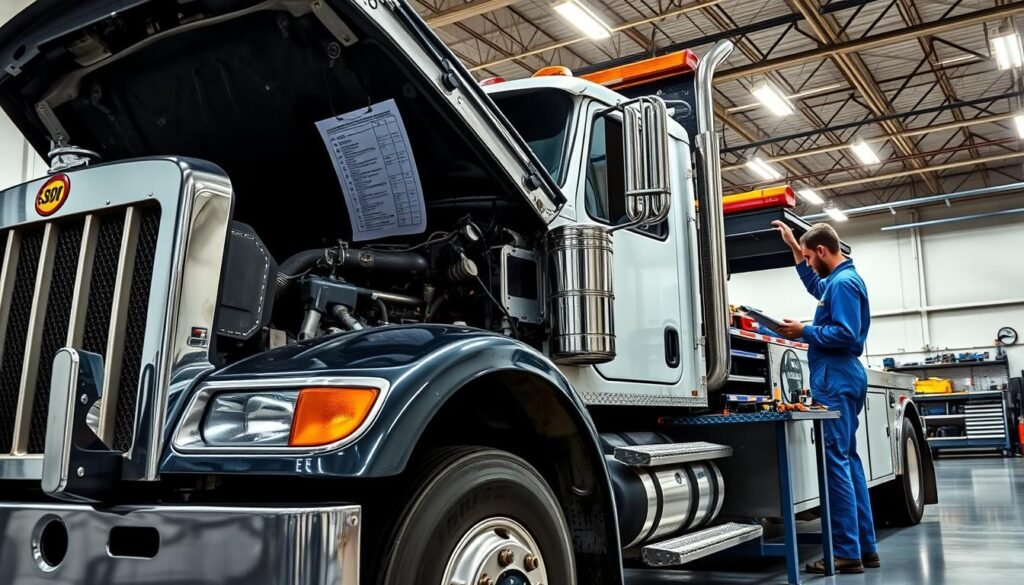
Your heavy duty tow truck is more than a vehicle. It’s your key to helping others on the road. To keep it running well, you need to stay on top of maintenance, even in Canada’s cold winters. Here’s how to avoid expensive repairs with regular care.
Routine Inspections and Checks
Do a quick check every day to avoid big problems. Look at tire pressure, fluid levels, and brake lines. For weekly tasks:
- Test all lights (headlights, hazard signals, brake lights)
- Inspect hydraulic systems for leaks
- Verify winch cable integrity
Every month, use Ford’s onboard scales system to check load capacity. This helps avoid overloading during rescue jobs. No more worries about the weight of a semi breaking your truck!
Common Maintenance Issues
Brake pads wear out faster when towing heavy loads. If you hear grinding or feel delayed stops, it’s time to check. Ram’s air suspension systems also need extra care. Clean debris from airbags monthly to avoid damage.
Electrical issues are common in tow trucks. Corroded connectors cause 40% of delays. Spray dielectric grease on terminals every 3 months to keep connections good.
Seasonal Preparations
Canadian winters require special preparation. Switch to -40°C antifreeze by October. Keep your cab stocked with:
- Ice scrapers and de-icer
- Sandbags for rear axle traction
- Portable jump starter
Ram owners: Cold weather thickens air suspension lubricants. Use synthetic grease in November to keep it smooth during snow recoveries.
Leading Brands and Models
Choosing the right heavy-duty tow truck is more than just power. It’s about finding gear that works as hard as you do. Let’s look at the top brands and models for 2025. Whether you’re driving on icy Manitoba roads or climbing Vancouver’s steep mountains.
Brands Known for Reliability
For jobs that need durability, these names are trusted:
- Freightliner: Built for Canadian winters with heated mirrors and corrosion-resistant frames
- Kenworth: Offers specialized packages for off-road recovery missions
- Volvo: Leads in safety tech like rollover protection systems
- Peterbilt: Known for customizable cabs that reduce driver fatigue
Notable Models in 2025
This year’s top models are smart and strong:
| Model | Key Feature | Best For |
|---|---|---|
| GMC Sierra HD | Super Cruise hands-free towing | Long highway hauls |
| Ram 3500 HD | Trailer Reverse Steering | Tight urban recoveries |
| Ford F-450 Super Duty | Pro Trailer Hitch Assist | Heavy hauling stability |
Comparison of Features and Prices
Let’s focus on what really matters:
- Tech showdown: GMC’s Super Cruise vs Ram’s steering knob. The first keeps you alert on straightaways, while the second makes backing up trailers feel like playing video games.
- Cab configurations: Extended cabs dominate ice road routes (extra storage for survival gear), while crew cabs rule mountain passes (space for additional crew members).
- Price ranges: Expect $85K-$150K CAD for new models. Used 2022-2024 trucks with under 100K km often save you $20K+.
Pro tip: Look for models with integrated weight sensors. They’re a game-changer for off-road recovery jobs where load balance shifts constantly.
Heavy Duty Towing Insurance Considerations
Imagine hauling a flipped semi-trailer at 3 AM and things go wrong. Without the right insurance, it could be a huge financial burden. We’ll look at how to protect your business and save money for accident recovery and commercial towing jobs.
Types of Coverage You Can’t Skip
Insurance policies vary. In Canada, Alberta needs $2 million in liability coverage for heavy duty towing. Ontario requires $1 million. You’ll need:
- Primary liability: Covers damage to others’ property
- On-hook insurance: Protects vehicles you’re moving
- Garagekeepers coverage: Shields customer vehicles in storage
What Determines Your Premium Costs?
Insurance companies look at more than just your driving record. These factors affect your rates:
| Factor | Cost Impact | Quick Fix |
|---|---|---|
| GPS tracking | Up to 15% discount | Install fleet tracking software |
| Safety cameras | $3K+ annual savings | Use 360° dash cams |
| Driver certifications | 10-20% lower premiums | Require annual training |
Smart Claim Management Strategies
When filing claims, good documentation is key. An Ontario operator cut claim denials by 40% with this checklist:
- Take timestamped photos before moving vehicles
- Record weather and road conditions
- Get written confirmation from emergency responders
For nightshift recoveries, check your policy’s after-hours rules. Some insurers need extra safety for dawn-to-dusk work.
Innovations in Heavy Duty Tow Truck Technology
Canadian winters meet electric muscle – discover how new tow truck tech handles extreme challenges. Whether you’re hauling equipment transport loads or handling tricky winch-out services, these upgrades make tough jobs safer and more efficient. Let’s explore what’s under the hood of 2025’s most exciting advancements.
Electric and Hybrid Options
Freezing temperatures? No problem. New electric models like Quebec’s trial units start reliably at -30°C – perfect for Canadian climates. The Ford Pro Trailer Hitch Assist and GMC’s 14-camera system let you hitch loads solo in tight spaces. Check out how these green machines stack up:
| Feature | Electric/Hybrid | Traditional Diesel |
|---|---|---|
| Cold Start Performance | Instant -30°C starts | Requires block heaters |
| Fuel Costs | 60% lower | Market-dependent |
| Noise Level | Quiet operation | Loud engine noise |
Advanced Towing Systems
Smart tech now does the heavy lifting. AI systems calculate perfect winch tension before you hook up, reducing equipment strain. Hydraulic stabilizers auto-level on uneven terrain – critical for safe winch-out services. These systems learn from every recovery, getting smarter with each job.
Software and Tracking Solutions
Real-time tracking does more than show locations. New platforms analyze traffic, weather, and road closures to suggest faster routes. Dispatch systems automatically match jobs to nearby trucks, cutting response times. You’ll even get maintenance alerts before parts fail – no more roadside surprises.
Conclusion: The Future of Heavy Duty Tow Trucks
Heavy duty tow trucks are changing quickly, like a semi on an icy road. By 2025, there will be a big increase in roadside assistance needs in places like Ontario and Alberta. Your role in this change is very important.
Where Rubber Meets Innovation
Electric heavy duty trucks from Freightliner and Kenworth can lift 25 tons without diesel. GPS systems like LoJack work with provincial databases for quick accident help. These are not just updates – they are essential for today’s fast-paced world.
Knowledge Fuels Reliability
New carbon pricing rules will change maintenance costs. CSA standards now require specific safety equipment. To stay up-to-date, work with certified training programs like Trucking HR Canada. The Canadian Towing Association also offers webinars to keep your skills current.
Your Next Move Matters
Choosing the right heavy duty tow truck is more than just looking at specs. It’s about building trust in your community. Whether it’s a whiteout in Winnipeg or a rescue in Banff, your fleet is key to safety.
Are you ready to take the lead? Keep this guide handy, check your oil regularly, and remember. The best towers don’t just react to emergencies. They prepare for them.
FAQ
What makes heavy duty tow trucks different from regular tow trucks?
Heavy duty tow trucks, like Ford’s 2025 models, can tow up to 13,500 lbs. They have special frames and systems for steering trailers. They’re made for semi-trailers and commercial vehicles, not just cars.
When should I choose a flatbed tow truck over other types?
Choose a flatbed, like GMC’s 2025 model, for transporting equipment or delicate recoveries. They’re great for loading construction machinery or vehicles that need extra care. Their hydraulic decks keep loads stable, even on tough terrain.
What engine specs matter most for heavy hauling?
Look for torque over horsepower. Ford’s 720HP Raptor engine works with 10-speed transmissions for power control. Ram’s 50-gallon fuel tanks help keep you going on long trips. Cool systems prevent overheating in cold weather.
What licenses do I need for commercial towing in Canada?
In Ontario, you need a Class D license with air brake endorsements for trucks over 11,000 kg. Quebec requires recovery training, and BC needs special permits for mountain routes. Always check weight limits – federal rules cap at 63,500 kg.
How do I prevent fines during accident recoveries?
Use Ford’s load scales to avoid overweight fines. Our checklist includes permits, safety chains, and Ontario’s M insurance. GPS trackers help document routes if needed.
Should I buy new or used heavy duty tow trucks?
Used trucks are good for local jobs, but new ones save money on long trips. GMC’s Duramax diesel costs
FAQ
What makes heavy duty tow trucks different from regular tow trucks?
Heavy duty tow trucks, like Ford’s 2025 models, can tow up to 13,500 lbs. They have special frames and systems for steering trailers. They’re made for semi-trailers and commercial vehicles, not just cars.
When should I choose a flatbed tow truck over other types?
Choose a flatbed, like GMC’s 2025 model, for transporting equipment or delicate recoveries. They’re great for loading construction machinery or vehicles that need extra care. Their hydraulic decks keep loads stable, even on tough terrain.
What engine specs matter most for heavy hauling?
Look for torque over horsepower. Ford’s 720HP Raptor engine works with 10-speed transmissions for power control. Ram’s 50-gallon fuel tanks help keep you going on long trips. Cool systems prevent overheating in cold weather.
What licenses do I need for commercial towing in Canada?
In Ontario, you need a Class D license with air brake endorsements for trucks over 11,000 kg. Quebec requires recovery training, and BC needs special permits for mountain routes. Always check weight limits – federal rules cap at 63,500 kg.
How do I prevent fines during accident recoveries?
Use Ford’s load scales to avoid overweight fines. Our checklist includes permits, safety chains, and Ontario’s $2M insurance. GPS trackers help document routes if needed.
Should I buy new or used heavy duty tow trucks?
Used trucks are good for local jobs, but new ones save money on long trips. GMC’s Duramax diesel costs $0.42/km, while Ford’s hybrid PowerBoost is $0.38/km. New trucks break even at ~80,000 km annually.
What winter prep prevents breakdowns during blizzard recoveries?
Treat Ram’s air suspension with cold-weather lubricants and install block heaters for -40°C starts. Our checklist includes testing heated mirrors and stocking 20L diesel antifreeze. Use traction mats – they help Winnipeg operators recover faster.
How does insurance work for off-road recovery operations?
Alberta needs $2M liability, but $5M is safer for equipment transport. Install 360° cameras for discounts. Document recoveries with photos – one Ontario operator saved $14K with dashcam footage.
Can electric tow trucks handle Canadian winters?
GMC’s 2025 electric prototype passed Quebec City trials with battery warmers and regen braking. Range drops 37% at -25°C, but instant torque helps winching. Charge times match diesel with 350kW stations – tested in Whitehorse.
What new tech helps prevent jackknifing during emergency tows?
A> Ford’s 2025 models use AI for faster trailer brake adjustments. Ram’s active steering assist also helps. This tech reduced BC highway incidents by 18% in trials. Use tire pressure monitoring – new cameras show PSI readings during tows.
.42/km, while Ford’s hybrid PowerBoost is
FAQ
What makes heavy duty tow trucks different from regular tow trucks?
Heavy duty tow trucks, like Ford’s 2025 models, can tow up to 13,500 lbs. They have special frames and systems for steering trailers. They’re made for semi-trailers and commercial vehicles, not just cars.
When should I choose a flatbed tow truck over other types?
Choose a flatbed, like GMC’s 2025 model, for transporting equipment or delicate recoveries. They’re great for loading construction machinery or vehicles that need extra care. Their hydraulic decks keep loads stable, even on tough terrain.
What engine specs matter most for heavy hauling?
Look for torque over horsepower. Ford’s 720HP Raptor engine works with 10-speed transmissions for power control. Ram’s 50-gallon fuel tanks help keep you going on long trips. Cool systems prevent overheating in cold weather.
What licenses do I need for commercial towing in Canada?
In Ontario, you need a Class D license with air brake endorsements for trucks over 11,000 kg. Quebec requires recovery training, and BC needs special permits for mountain routes. Always check weight limits – federal rules cap at 63,500 kg.
How do I prevent fines during accident recoveries?
Use Ford’s load scales to avoid overweight fines. Our checklist includes permits, safety chains, and Ontario’s $2M insurance. GPS trackers help document routes if needed.
Should I buy new or used heavy duty tow trucks?
Used trucks are good for local jobs, but new ones save money on long trips. GMC’s Duramax diesel costs $0.42/km, while Ford’s hybrid PowerBoost is $0.38/km. New trucks break even at ~80,000 km annually.
What winter prep prevents breakdowns during blizzard recoveries?
Treat Ram’s air suspension with cold-weather lubricants and install block heaters for -40°C starts. Our checklist includes testing heated mirrors and stocking 20L diesel antifreeze. Use traction mats – they help Winnipeg operators recover faster.
How does insurance work for off-road recovery operations?
Alberta needs $2M liability, but $5M is safer for equipment transport. Install 360° cameras for discounts. Document recoveries with photos – one Ontario operator saved $14K with dashcam footage.
Can electric tow trucks handle Canadian winters?
GMC’s 2025 electric prototype passed Quebec City trials with battery warmers and regen braking. Range drops 37% at -25°C, but instant torque helps winching. Charge times match diesel with 350kW stations – tested in Whitehorse.
What new tech helps prevent jackknifing during emergency tows?
A> Ford’s 2025 models use AI for faster trailer brake adjustments. Ram’s active steering assist also helps. This tech reduced BC highway incidents by 18% in trials. Use tire pressure monitoring – new cameras show PSI readings during tows.
.38/km. New trucks break even at ~80,000 km annually.
What winter prep prevents breakdowns during blizzard recoveries?
Treat Ram’s air suspension with cold-weather lubricants and install block heaters for -40°C starts. Our checklist includes testing heated mirrors and stocking 20L diesel antifreeze. Use traction mats – they help Winnipeg operators recover faster.
How does insurance work for off-road recovery operations?
Alberta needs M liability, but M is safer for equipment transport. Install 360° cameras for discounts. Document recoveries with photos – one Ontario operator saved K with dashcam footage.
Can electric tow trucks handle Canadian winters?
GMC’s 2025 electric prototype passed Quebec City trials with battery warmers and regen braking. Range drops 37% at -25°C, but instant torque helps winching. Charge times match diesel with 350kW stations – tested in Whitehorse.
What new tech helps prevent jackknifing during emergency tows?
A> Ford’s 2025 models use AI for faster trailer brake adjustments. Ram’s active steering assist also helps. This tech reduced BC highway incidents by 18% in trials. Use tire pressure monitoring – new cameras show PSI readings during tows.
